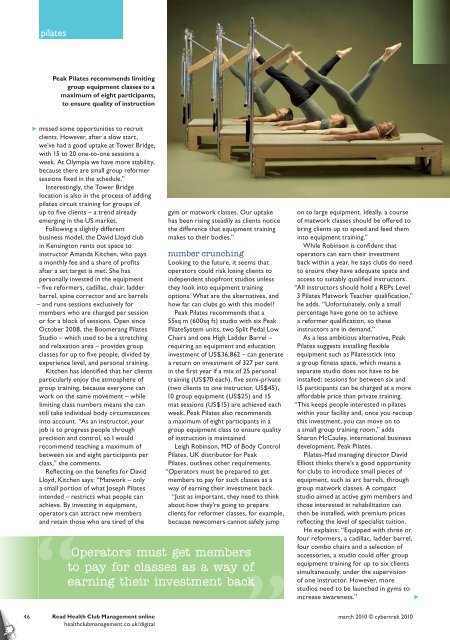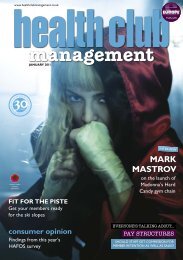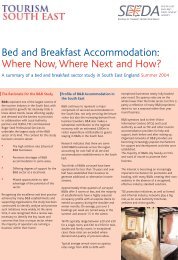Leisure Media HCM March 2010 - TourismInsights
Leisure Media HCM March 2010 - TourismInsights
Leisure Media HCM March 2010 - TourismInsights
You also want an ePaper? Increase the reach of your titles
YUMPU automatically turns print PDFs into web optimized ePapers that Google loves.
pilates<br />
Peak Pilates recommends limiting<br />
group equipment classes to a<br />
maximum of eight participants,<br />
to ensure quality of instruction<br />
missed some opportunities to recruit<br />
clients. However, after a slow start,<br />
we’ve had a good uptake at Tower Bridge,<br />
with 15 to 20 one-to-one sessions a<br />
week. At Olympia we have more stability,<br />
because there are small group reformer<br />
sessions fi xed in the schedule.”<br />
Interestingly, the Tower Bridge<br />
location is also in the process of adding<br />
pilates circuit training for groups of<br />
up to fi ve clients – a trend already<br />
emerging in the US market.<br />
Following a slightly different<br />
business model, the David Lloyd club<br />
in Kensington rents out space to<br />
instructor Amanda Kitchen, who pays<br />
a monthly fee and a share of profi ts<br />
after a set target is met. She has<br />
personally invested in the equipment<br />
– fi ve reformers, cadillac, chair, ladder<br />
barrel, spine corrector and arc barrels<br />
– and runs sessions exclusively for<br />
members who are charged per session<br />
or for a block of sessions. Open since<br />
October 2008, the Boomerang Pilates<br />
Studio – which used to be a stretching<br />
and relaxation area – provides group<br />
classes for up to fi ve people, divided by<br />
experience level, and personal training.<br />
Kitchen has identifi ed that her clients<br />
particularly enjoy the atmosphere of<br />
group training, because everyone can<br />
work on the same movement – while<br />
limiting class numbers means she can<br />
still take individual body circumstances<br />
into account. “As an instructor, your<br />
job is to progress people through<br />
precision and control, so I would<br />
recommend teaching a maximum of<br />
between six and eight participants per<br />
class,” she comments.<br />
Refl ecting on the benefi ts for David<br />
Lloyd, Kitchen says: “Matwork – only<br />
a small portion of what Joseph Pilates<br />
intended – restricts what people can<br />
achieve. By investing in equipment,<br />
operators can attract new members<br />
and retain those who are tired of the<br />
gym or matwork classes. Our uptake<br />
has been rising steadily as clients notice<br />
the difference that equipment training<br />
makes to their bodies.”<br />
number crunching<br />
Looking to the future, it seems that<br />
operators could risk losing clients to<br />
independent shopfront studios unless<br />
they look into equipment training<br />
options. What are the alternatives, and<br />
how far can clubs go with this model?<br />
Peak Pilates recommends that a<br />
55sq m (600sq ft) studio with six Peak<br />
PilateSystem units, two Split Pedal Low<br />
Chairs and one High Ladder Barrel –<br />
requiring an equipment and education<br />
investment of US$36,862 – can generate<br />
a return on investment of 327 per cent<br />
in the fi rst year if a mix of 25 personal<br />
training (US$70 each), fi ve semi-private<br />
(two clients to one instructor, US$45),<br />
10 group equipment (US$25) and 15<br />
mat sessions (US$15) are achieved each<br />
week. Peak Pilates also recommends<br />
a maximum of eight participants in a<br />
group equipment class to ensure quality<br />
of instruction is maintained.<br />
Leigh Robinson, MD of Body Control<br />
Pilates, UK distributor for Peak<br />
Pilates, outlines other requirements.<br />
“Operators must be prepared to get<br />
members to pay for such classes as a<br />
way of earning their investment back.<br />
“Just as important, they need to think<br />
about how they’re going to prepare<br />
clients for reformer classes, for example,<br />
because newcomers cannot safely jump<br />
Operators must get members<br />
to pay for classes as a way of<br />
earning their investment back<br />
on to large equipment. Ideally, a course<br />
of matwork classes should be offered to<br />
bring clients up to speed and feed them<br />
into equipment training.”<br />
While Robinson is confi dent that<br />
operators can earn their investment<br />
back within a year, he says clubs do need<br />
to ensure they have adequate space and<br />
access to suitably qualifi ed instructors.<br />
“All instructors should hold a REPs Level<br />
3 Pilates Matwork Teacher qualifi cation,”<br />
he adds. “Unfortunately, only a small<br />
percentage have gone on to achieve<br />
a reformer qualifi cation, so these<br />
instructors are in demand.”<br />
As a less ambitious alternative, Peak<br />
Pilates suggests installing fl exible<br />
equipment such as Pilatesstick into<br />
a group fi tness space, which means a<br />
separate studio does not have to be<br />
installed; sessions for between six and<br />
15 participants can be charged at a more<br />
affordable price than private training.<br />
“This keeps people interested in pilates<br />
within your facility and, once you recoup<br />
this investment, you can move on to<br />
a small group training room,” adds<br />
Sharon McCauley, international business<br />
development, Peak Pilates.<br />
Pilates-Mad managing director David<br />
Elliott thinks there’s a good opportunity<br />
for clubs to introduce small pieces of<br />
equipment, such as arc barrels, through<br />
group matwork classes. A compact<br />
studio aimed at active gym members and<br />
those interested in rehabilitation can<br />
then be installed, with premium prices<br />
refl ecting the level of specialist tuition.<br />
He explains: “Equipped with three or<br />
four reformers, a cadillac, ladder barrel,<br />
four combo chairs and a selection of<br />
accessories, a studio could offer group<br />
equipment training for up to six clients<br />
simultaneously, under the supervision<br />
of one instructor. However, more<br />
studios need to be launched in gyms to<br />
increase awareness.”<br />
46<br />
Read Health Club Management online<br />
healthclubmanagement.co.uk/digital<br />
march <strong>2010</strong> © cybertrek <strong>2010</strong>
















